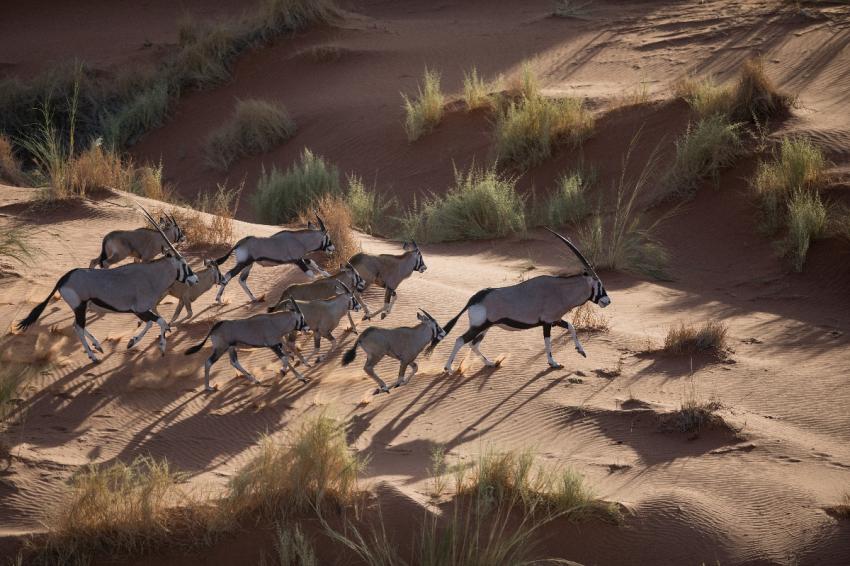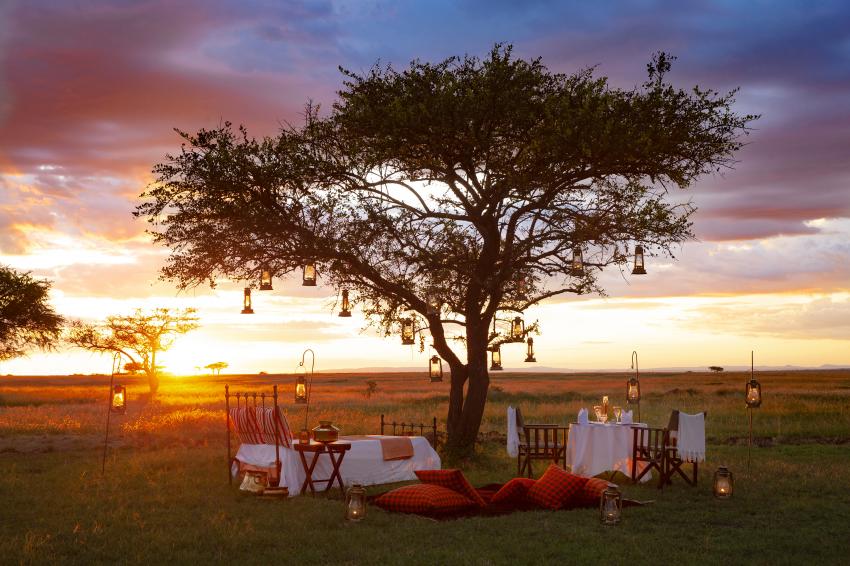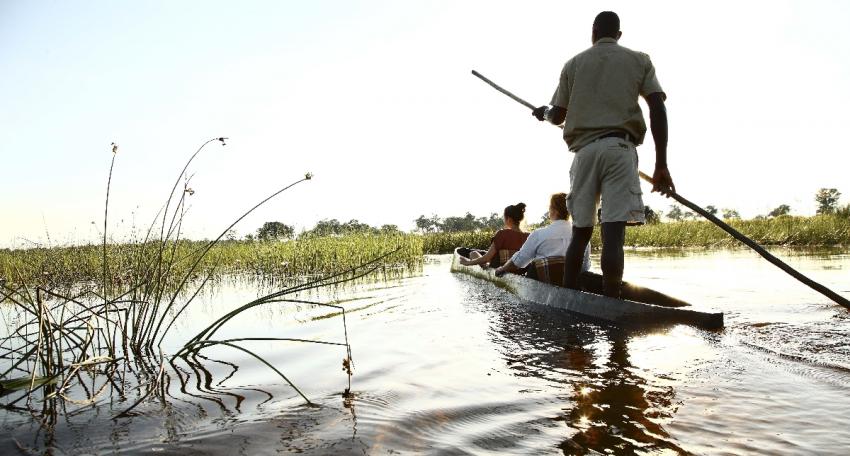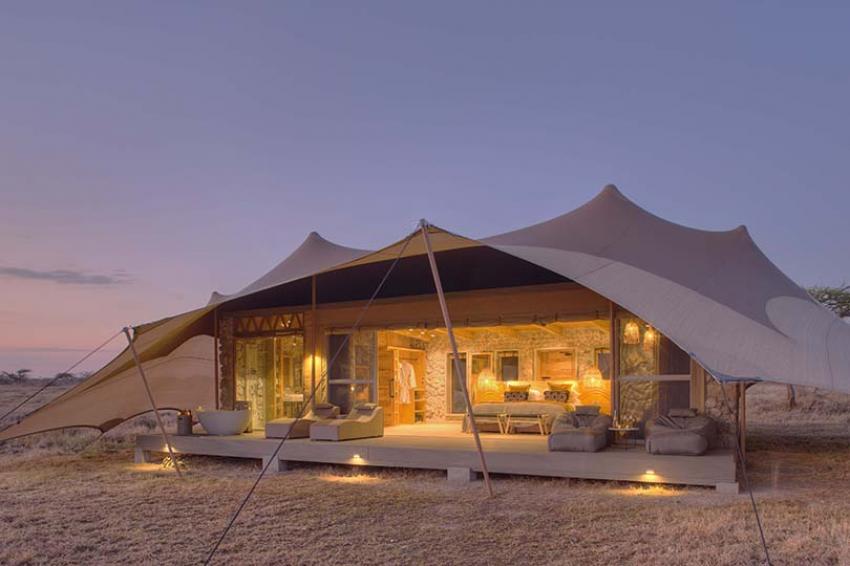Home to some of the world’s most iconic wildlife species, Africa is synonymous with safari tourism. It offers once-in-a-lifetime encounters with huge herds of elephants and the opportunity to see a lion “kill”, all amidst some of the most breathtaking landscapes Mother Nature has created.
But if you’re trying to plan an African safari, you might be overwhelmed with the choices available and not sure where to start. To help you plan an unforgettable adventure, we’ve put together this ultimate Africa safari guide to answer some of the most commonly asked questions.
Where to go on an African safari

Africa’s Eastern, Southern and Central regions are the most popular destinations for going on safari, with landscapes that range from acacia-dotted savannah to lush rainforests and bird-filled lakes. An African safari might mean ticking off the “Big Five” on Tanzania’s Northern Circuit or spotting mountain gorillas in Rwanda and Uganda, or it may mean participating in an educational family adventure in Kruger National Park.
Determining where you want to go on safari will depend on what you want to see and the type of safari experience you’re after. In this guide, we’ll break down the basics of what each destination offers to help you make an informed decision.
Tanzania
Boasting some of East Africa’s premier wildlife-viewing destinations and the setting for the Great Wildebeest Migration, Tanzania is one of the continent’s most popular safari destinations. It’s home to iconic wildlife-viewing reserves such as the Serengeti and the Ngorongoro Crater, as well as lesser-known parks such as Gombe and Mahale where you can see chimpanzees in the wild.

Before or after your safari, you can trek to the summit of Africa’s highest peak, Mount Kilimanjaro, or relax on the idyllic beaches of exotic Zanzibar. There are exceptional lodges and camps for travellers wanting a luxurious experience, whether you’re ticking off the “Big Five” on the Northern Circuit or discovering the little-visited reserves of the Southern Circuit.
Kenya
Carved by the Great Rift Valley and providing the setting for “Out of Africa”, Kenya offers some of Africa’s most recognisable safari destinations. It’s here that you’ll find the Maasai Mara National Reserve, which is not only home to the iconic red-robed tribe but also the setting for the annual Great Wildebeest Migration.

You can soak up the spectacular views of Mount Kilimanjaro from Amboseli National Park or explore the flamingo-filled shores of Lake Nakuru, then venture to the remote Turkana region to meet its diverse tribal communities. Kenya boasts some of East Africa’s most exclusive safari lodges and camps, as well as a postcard-perfect stretch of Indian Ocean coastline where you can relax at the end of your adventure.
South Africa

Located at the southernmost tip of the African continent, South Africa is home to big-ticket wildlife parks such as Kruger and Sabi Sands where you have a good chance of ticking the “Big Five” off your list. But it’s also a mecca for surfing, diving and wine-tasting, with stunning viticultural regions such as the Cape Winelands to explore. You can begin or end your safari in the colourful streets of Johannesburg or bunk down beneath the iconic peak of Table Mountain in beautiful Cape Town.
Namibia

With Etosha National Park the jewel in its wildlife-viewing crown, Namibia is a country of dramatic deserts and sand dunes that’s garnered a reputation for its self-drive safaris. It’s home to a variety of unique desert-adapted wildlife species that you won’t see anywhere else, as well as otherworldly landscapes such as Deadvlei. Adrenalin junkies can get their fix in the German-inspired streets of Swakopmund before photographing the shipwrecks that dot the aptly-named Skeleton Coast.
Botswana

Famed for the watery wonderland of the Okavango Delta, Botswana is one of Africa’s most high-end safari destinations. It boasts exclusive lodges and camps where you can enjoy private wildlife viewing experiences on foot or by mokoro canoe, as well as boating safaris along the wildlife-frequented waters of the Chobe River. Aside from its wildlife encounters, Botswana is also home to the Bushmen of the Kalahari who welcome tourists wanting to learn about their ancient hunting and gathering traditions.
Zambia and Zimbabwe

Sharing access to Victoria Falls, landlocked Zambia and Zimbabwe tend to attract seasoned safari travellers with their off-the-beaten-track wildlife viewing experiences. Zambia is renowned for its rustic lodges and camps where wildlife is known to stroll through the grounds while Zimbabwe is home to the UNESCO-listed Mana Pools National Park, a remote but spellbindingly beautiful destination for those willing to make the journey.
Uganda

Stretching from the snow-capped Rwenzori Mountains down to the shores of Lake Victoria, Uganda is home to impressive wildlife reserves and one of the world’s last remaining populations of mountain gorillas. Trekking to see them along the forested slopes of Bwindi Impenetrable National Park is an undeniable highlight and can easily be combined with a safari through biodiverse Queen Elizabeth National Park. Hike to the spectacular falls of Murchison Falls National Park or combine your Uganda gorilla trekking with a safari in neighbouring Kenya or Tanzania.
Rwanda

Nicknamed the “Land of a Thousand Hills”, Rwanda is characterised by gently rolling landscapes and the sparkling waters of Lake Kivu. Alongside Uganda, it’s become a major hub for mountain gorilla tourism, with these endearing primates inhabiting the slopes of Volcanoes National Park. After coming face-to-face with gorillas, you can cycle the legendary Congo Nile Trail or discover Rwanda’s poignant history in the friendly capital, Kigali.
What are the best African safari tours?

With so many African safari tours and operators on the market, you might be overwhelmed with the choices and unsure about what to look for when finding the best. You might initially start by comparing safaris based on price alone and opt for the cheapest. But it’s important to look beyond the price tag and consider a number of other factors in your decision so you don’t end up with a horror safari story!
The best African safari tours are run by operators with years of experience in the region who always have a Plan B if the unexpected happens. They employ highly knowledgeable guides and keep their jeeps in top condition while ensuring their drivers have enough experience to handle even the wettest roads.
Before you book an African safari, always carefully check what is included (and what’s not) so you don’t end up with any unexpected add-ons once you’ve signed the contract. A cheap safari that seems too good to be true probably is, with corners cut along the way or additional fees added to your bill. Perhaps they’re not paying their guides a fair wage or they’re exploiting the local community. Maybe their sustainability and conservation practices leave a lot to be desired.
One of the easiest ways to find a reputable tour operator offering the best African safari tours is by looking at online reviews. Previous travellers can give you insider advice about how the experience was and whether they would recommend it to others. Are there areas that could have been improved or were their expectations exceeded? There’s nothing like word of mouth to give you peace of mind before you sign on the dotted line.
Check out our sample safari packages here
What does an African safari cost?

An African safari can vary widely in price, with everything from budget-friendly overland trips to luxurious safaris with all the bells and whistles included. While you might think that Africa is an inexpensive place to live, most of the wildlife reserves and national parks (and their associated camps and lodges) are remotely situated and need to transport in goods, produce and people to create the experiences they do.
Add to that the services of highly-experienced guides and park entrance fees, and you might be surprised just how much an African safari costs. The price will not only be impacted by the style of accommodation you select (budget, mid-range or high-end) but also the activities, meals and perhaps even alcoholic drinks that are included. It may also reflect the quality of safari vehicles that you will be travelling in (and how regularly they undergo maintenance), as well as the level of exclusivity you can expect.
When budgeting for your Africa safari, also be aware that prices can vary significantly between the low and high seasons. If you have your heart set on a destination but the price seems out of your budget, check whether any shoulder or wet season deals are available.
At Vencha Travel, our Africa safari itineraries start from around US $3,500 per person for a seven-day classic experience, up to around US $10,000 per person for a luxury safari. Gorilla trekking permits will significantly increase the price, as will charter flights if you prefer to fly between destinations.
When to go on an African safari

June through to October is generally considered the best time to go on safari in South and East Africa, with less vegetation making the animals easier to spot and a reduced chance of rainfall to disrupt your outdoor adventures. But the ideal time to go on an African safari will depend on which destination(s) you’re planning on visiting as the seasons differ slightly across the region.
If you want to see the Great Wildebeest Migration on the plains of Kenya’s Mara region, then July through to October is the best time to visit. Alternatively, you can plan your safari for the short dry season that extends from January through to March when the scarcity of water lures wildlife to the riverbanks and lakes.
If you want to see the Great Wildebeest Migration in Tanzania, then head to the Serengeti or Ngorongoro Conservation Area in February or March when you can see the wildebeest and zebras rearing their young. This attracts high concentrations of opportunistic predators, making it an ideal time for big cat encounters. But in general, the dry season from June to October is generally considered the best time to visit Tanzania, with the thinner vegetation and limited water sources making wildlife much easier to spot.
July through to October is also considered the best time to go on safari in Zimbabwe. But you should consider visiting later in the season (August onwards) if you plan on rafting the Zambezi River as the water levels are lower and the rapids faster! Victoria Falls is most impressive, however, towards the end of the rainy season (March/April).
If you’re heading to Botswana, you can plan your safari a little earlier, with June to September the best time to go. Huge herds of big game species congregate around the Okavango Delta, making it particularly magnificent. If the high price of a dry season safari in Botswana is all too much, you might want to consider the shoulder months of April/May and October.
Uganda and Rwanda’s national parks are best visited from December through to March or June through to September during the countries’ dry seasons. Although rain can be expected year-round in the mountainous regions, this is also the best time to trek to see the mountain gorillas of Bwindi Impenetrable National Park or Volcanoes National Park when the trails are much easier to negotiate.
Zambia’s best wildlife encounters are generally at the end of the dry season (around September to mid-November) when large numbers congregate in the Lower Zambezi Valley. Alternatively, you may opt to visit between April and September but avoid the rainy season when many of the country’s safari lodges close down altogether.
South Africa’s Kruger National Park is best visited from June through to September when the dry days intersperse with cool nights. Wildlife congregates around the limited water sources (making them easier to see), although you will have to compete with large numbers of other visitors making the most of the conditions.
Namibia’s wildlife viewing tends to be at its best between May and September when Etosha’s watering holes attract large numbers of big game species. But if you’re a bird enthusiast, plan your trip during the summer months that extend from December through to March when migratory species arrive from near and far.
What to pack for an African safari

Going on safari is a little different from other holidays when it comes to packing. This is why it’s important that you don’t leave it to the last minute, as you may need to buy additional clothing, accessories or equipment for your adventure.
When it comes to clothing, you want casual, comfortable garments that are easy to wash and (ideally) quick drying. Neutral colours such as beige, khaki or green are best as they will help you blend into the foliage, without attracting the wildlife’s attention.
Aside from T-shirts, pack a couple of long sleeves shirts that will protect your arms from the sun during the day and guard against mosquito bites at night. Similarly, consider long pants in addition to shorts (or a pair of pants with zip-off legs) that will give you adequate protection in the evenings.
Don’t forget to pack a sweater for the chilly early mornings and evenings (they can be colder in Africa than you might think!) and a lightweight waterproof jacket in case of rain. A comfortable pair of walking shoes with good grip is also essential, as well as flip flops for getting around the camp or lodge.
When it comes to accessories, ensure you pack a broad-rimmed hat that will protect against the sun, plus sunglasses and sunscreen. Insect repellant should also be added to your personal toiletry kit, together with things like lip balm and moisturiser. If you take any prescription medication, ensure you have enough from your doctor for the entire trip as finding it on arrival may be next to impossible.
A basic first aid kit containing bandages, painkillers and antiseptic cream is also a good idea, although your lodge/camp will probably have a comprehensive kit on site. A pair of binoculars and a high-quality camera will also come in handy for documenting your adventures, as well as any power adaptors you might need to charge your electronic devices.
Lastly, don’t forget your passport, tickets and any vaccination records (such as Yellow Fever) that you may need, as well as a comprehensive travel insurance policy. While the chance of something happening is highly unlikely, this will cover you in case of unexpected situations, including (most importantly) medical evacuation.
Why go on an African safari

Going on an African safari is a bucket list dream for many travellers…and for good reason! Anyone who’s returned from safari will tell you that it’s an adventure like no other and a far cry from seeing animals in a zoo. But if you’re still not sure, here are 5 reasons why you should go on an African safari to inspire you.
1. To see “The Greatest Wildlife Show on Earth”
The Great Wildebeest Migration has been dubbed “The Greatest Wildlife Show on Earth” and after seeing its huge herds, you’ll understand why. Picture over a million wildebeest and hundreds of thousands of zebras and gazelles on their annual journey north from the Serengeti to the Maasai Mara in search of fresh grazing pastures. Hot on their pursuit are opportunistic lions, leopards and cheetahs hoping to score themselves a feed while crocodiles lurk in the waters of the Mara River - an obstacle the herds have no choice but to cross. Seeing this wildlife spectacle is a once-in-a-lifetime experience and something you can only do in Africa.
2. To tick the “Big Five” off your list
Once you’ve heard the term “Big Five”, you’ll soon be on a mission to see them with your own eyes. They include the African lion, African leopard, African bush elephant and Cape buffalo, as well as both black and white rhinoceros. Many of Africa’s wildlife reserves and national parks are home to all five species or you can combine a number of destinations to tick all off your list. Decades of hunting and poaching have had a big impact on their populations, with many now listed as either endangered or threatened. So it may be a case of now or never if you want the best chance of seeing them.
3. To discover little known species
Apart from iconic animals like the “Big Five”, giraffes and zebras, Africa’s wildlife parks and reserves are also home to little-known species that are no less fascinating. An African safari is one of the best ways to learn about some of the continent’s quirkiest critters, from tiny reptiles to unique subspecies that are endemic to one area. While game drive safaris will help you to see a lot of different animals in a short space of time, a walking safari will allow you to get up close and personal while discovering species that might otherwise get overlooked.
4. To support wildlife conservation efforts
Safari tourism in Africa is one of the biggest supporters of conservation efforts on the continent, helping to keep poaching at bay and ensuring species can survive for future generations. By staying in environmentally responsible lodges and camps or supporting community conservation initiatives, your tourism dollars will be doing far more than just offering you an incredible holiday. Some safaris include visits to organisations who are doing their bit to protect Africa’s wildlife while many lodges and camps include direct donations in their packages.
5. To escape the hustle and bustle of daily life
No matter how good life is, we can all do with a break every now and again to recharge and gain perspective on the world. A safari in Africa is one of the best ways to escape city living and the daily grind while immersing yourself in the wonders of Mother Nature. Wake up to views of the wildlife-dotted plains and spend thrilling days game driving alongside majestic creatures, then be treated to sumptuous dining under the never-ending African sky. Going on safari is an experience everyone should have once in their lifetime and something you just can’t put a price tag on.


 1-321-766-6821
1-321-766-6821 



















